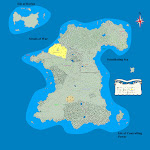
- Capital: Dun Maddock
- Government: Feudal King
- General Alignment: Lawful Good
- Population: ~825,000 (11/sq. mile)
- Area: 75,000 square miles
- % Cultivated: 6% (~4,600 sq. miles)
- Cities:
- Dun Maddock: The ancestral seat of the Clan-King resides in this stony citadel.
- Dun Morgh: built into a dormant volcano, this dark city holds the ancestral Clan-tombs.
- West Wailing: named for the spirits said to haunt the nearby fens, this is a human-dwarven city of traders and craftsmen.
- Townships: Dun Spire, Dun Vold, Aridok, Spellingcrown
Climate: Situated amidst the Knife Edge mountains, the region is typically hot and dry, though higher elevations have ample snowfall, especially in the north. Wind is a major threat, and windstorms are common in the region.
Geography: The Knife Edge mountains make up the geography of the Clanlands. Tall peaks, deep gorges, and rocky ravines abound in this rugged terrain. Only a few well-used paths allow transit through the region, though numerous underground passages have been carved by the dwarves to aid trade and travel. The region is bordered to the north by the Tuluvian Jungle, to the west by the great Sandstorm desert, to the south by the King’s forest, and to the east by the Dyninn forest and the Black marsh.
History and Politics: Dwarven legend tells of dwarf tribes settling the tall peaks in isolated bands during the time of the precursors. It wasn’t until well after the Dragon Wars – in the year EH 517 – that these small tribes would come together in what would be the first Clanmeet of the dwarves. Facing threats from the growing human populations, as well as continued conflicts with giant-kin in the region, the clans vowed to elect a king to unite them. After several long months of serious political negotiations, the first Dwarven Clan-King was chosen: Clan-King Dunnerholden Mordinhammer. Within three decades, he would establish the dwarven kingdom as the predominant force in the region.
Content to maintain their mountain strongholds, the dwarves become isolationist and reclusive. Trade occurred intermittently with the rapidly growing human tribes and kingdoms; the dwarves would unwittingly provide the humans with the tools to ultimately threaten them, by trading away the secrets to metallurgy, ironsmithing, and eventually steel.
Skirmishes between the humans and dwarves, and the dwarves and the Arbolorian elves of the Dyninn, were common. They would come to a head during the Dawn of War, when Chief Huri XV would strike the Treaty of Neutrality, allowing the soon-to-be King to march his forces thru the passes of the Knife Edge mountains.
Many years later, in EK 111, an increasingly isolationist Clan-King would seek a trade-embargo on the Sinter Dynasty, that would lead to the fabled Battle of Ep Pass. The Sinternian forces would rule the day, but their steep losses would drive them to the bargaining table. The Treaty of the Clans was signed, allying the Clan’s with the Kingdom.
Clan-Kings are chosen at every fifth clanmeet, which occur once every five years. Typically a Clan-King rules for life, unless he or she proves particularly unpopular.
Laws: The dwarven Clan-laws are very strict, and considered almost sacred by the Clan dwarves. Crimes involving material goods, such as theft, larceny, or vandalism are punishable by imprisonment, hard labor, and/or fines. Violent crimes can lead to exile, imprisonment, or even (rarely) capital punishment.
The courts of the Clans are considered very fair, and are presided over by clerics of Midir. Not even the Clan-King himself is exempt from the Clan-laws.
Economy: The dwarves of the Clanlands are renowned for their weapons, armor, and metal goods, as well as jewelry and precious metal ornaments. Marble and stone are also common exports. The Clanlands tend to import foodstuffs – mostly grains, beef, and pork to supplement their diets of fungus, mutton, and mountain vegetables.
Military and Clout: Almost every member of the Clans can serve as able-bodied militia in times of need. The professional military contingent are considered some of the hardiest, most dangerous warriors in the kingdom, lacking only in numbers. The mountainous citadels are nigh impregnable.




